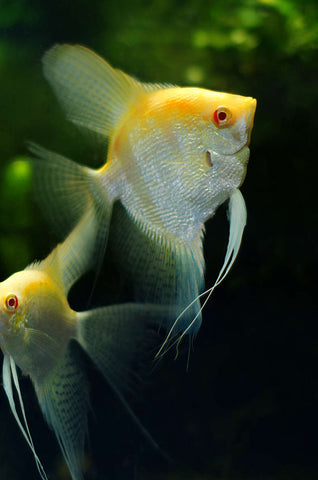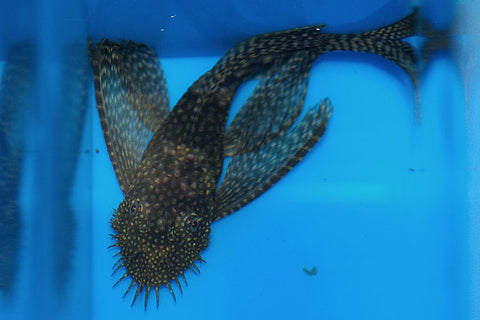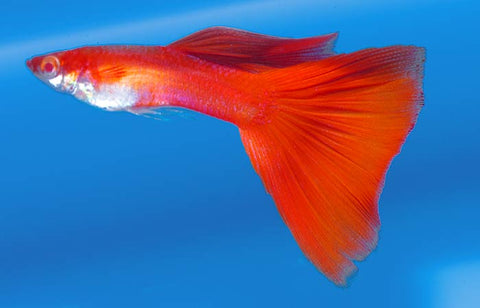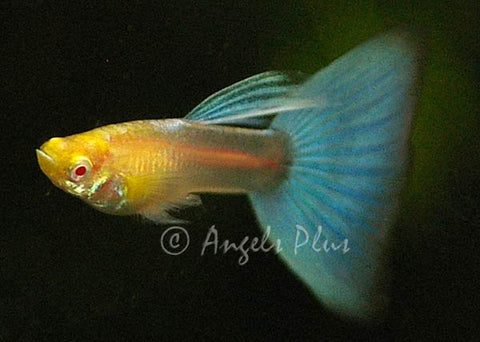A recent Facebook post on an angelfish group brought up the Albino gene in Dantum angelfish. It reminded me of an article I put in our former newsletter about the albino gene. It's the kind of observation that is important to me and thought I'd share it on the blog.

Normal Albino of the past 25 years.
Albinism is rather common in many ornamental fish varieties. However, it is just recently that we have become aware of the fact that it appears to commonly occur on more than one gene location. It's been several years that we have known it to be on at least 2 locations in our bristlenose pleco varieties. Breeding two albino plecos together and producing a percentage of wild-type (non-albino) is a good indication of albino on a different location in each parent. That first occurred in our spawns back about 10 years ago.

Recently, at an IFGA Show in Michigan, a few of us were invited into Simeon Bonev's fishroom. Simeon keeps mostly guppies, but he had a tank of angelfish he had gotten several months back. They came from Israel and were labeled Albino Altums when he brought them in. He asked my opinion of them and I said that while they certainly were not a variety of altum, they were different. They probably have some wild blood in them, but that wasn't what made them unique. The color was slightly different from the albinos I've kept for the past 23 years. After a few questions it got interesting. Turns out, this fish's offspring do not start out with the pink eyes and are somewhat silvery colored until they get older. The description Simeon gave me, reminded me of the old Naja Gold that has been lost to the hobby. Fortunately, he happened to have a newly hatched spawn from a pair of these albinos so I could see how they compared to our existing albino fry. I didn't think they looked anything like albino fry. They were super tiny. The eyes were not pink and the body was definitely more silver. I highly suspect that the Albino gene in Simeon's fish will be proven to be in a different location. It will be easy to test by anyone who has both types.
My most recent albino incident occurred about 2 years ago, but it took me about a year to figure out what was happening. I've had an albino strain of Red guppies for quite a few years.

A couple of years ago, I brought in some Albino Blue Topaz.

Like I normally do, some of them were out-crossed to other varieties including our Albino Red gups. The first couple drops from the albino/albino crosses were very odd - no albino offspring - none! Initially, I didn't think much of it because the females were not virgins. After a couple more drops without producing albinos, I became very suspicious. Some of the new male's sperm should have been used by then. In fact, my past experience tells me that most of the fry should have been from the latest males at that point. Then it hit me (with a little help from Dave Hlasnick). My Albino Red guppies did not have Halfblack in them, but I was getting some Halfblack offspring in the fry.

Dave verified that the Albino Blue Topaz carried halfblack (common in many albino strains). So, the fry from my Albino Red females were indeed from the Albino Blue topaz males - albino on two different locations! I have F2s about to drop and that will surely end up in a percentage of albino offspring. The problem is that if I can't figure out which fish carry which albino gene, they will be difficult to work with. Then again, there may be some slight, subtle difference in expression - at least I hope so.
So, now we have what looks like multiple albino locations on bristlenose and guppies. With angelfish it is a very high probability at this point in my opinion. I suspect that albino mutations occur on multiple locations more often than we originally thought. It may prove to be rather common and hopefully it results in varying gene expressions. Now, we just have to wait for someone with both albino types to make the cross.
Author's note (2019): It has since been confirmed that the Albino gene in Dantums is at a different location.
